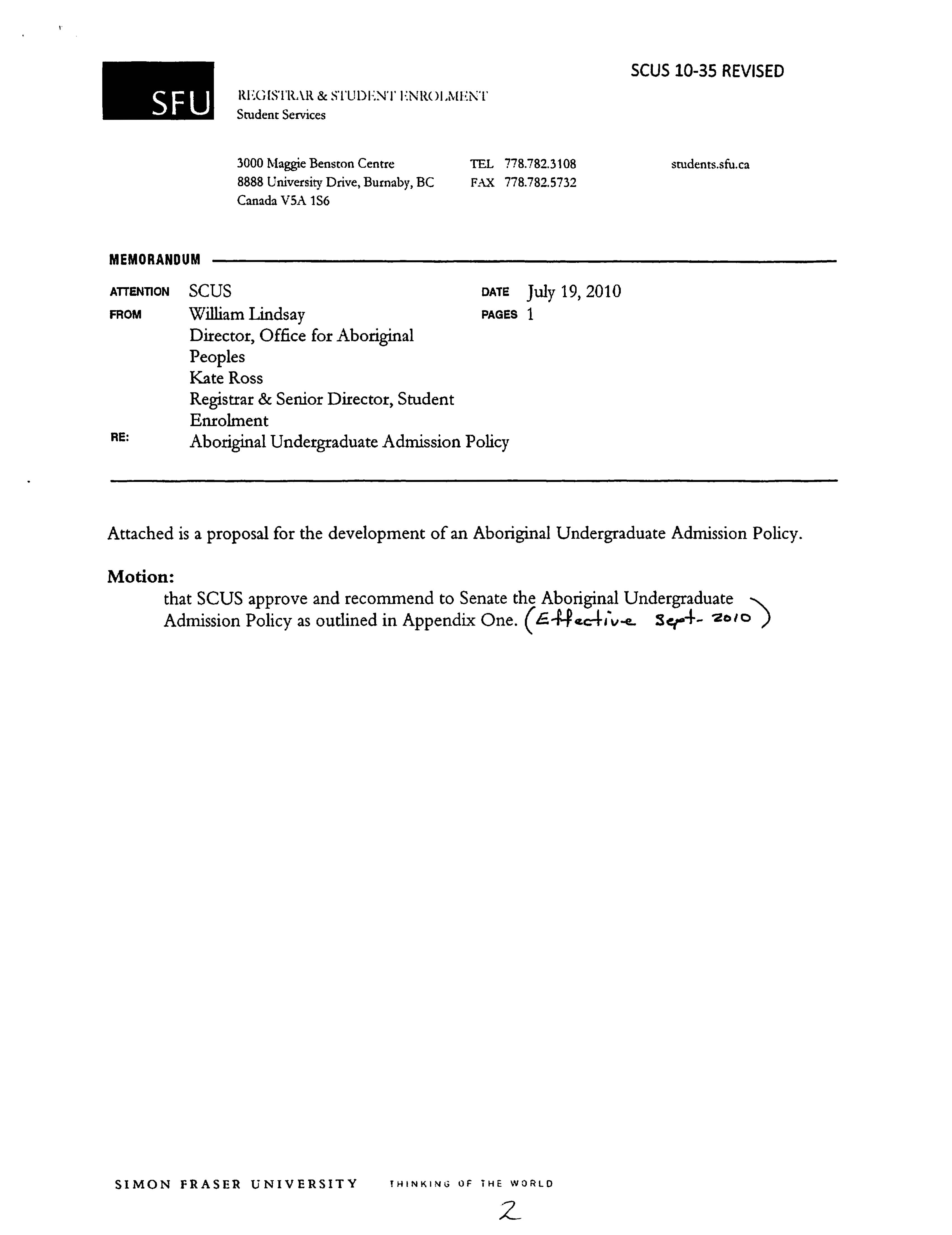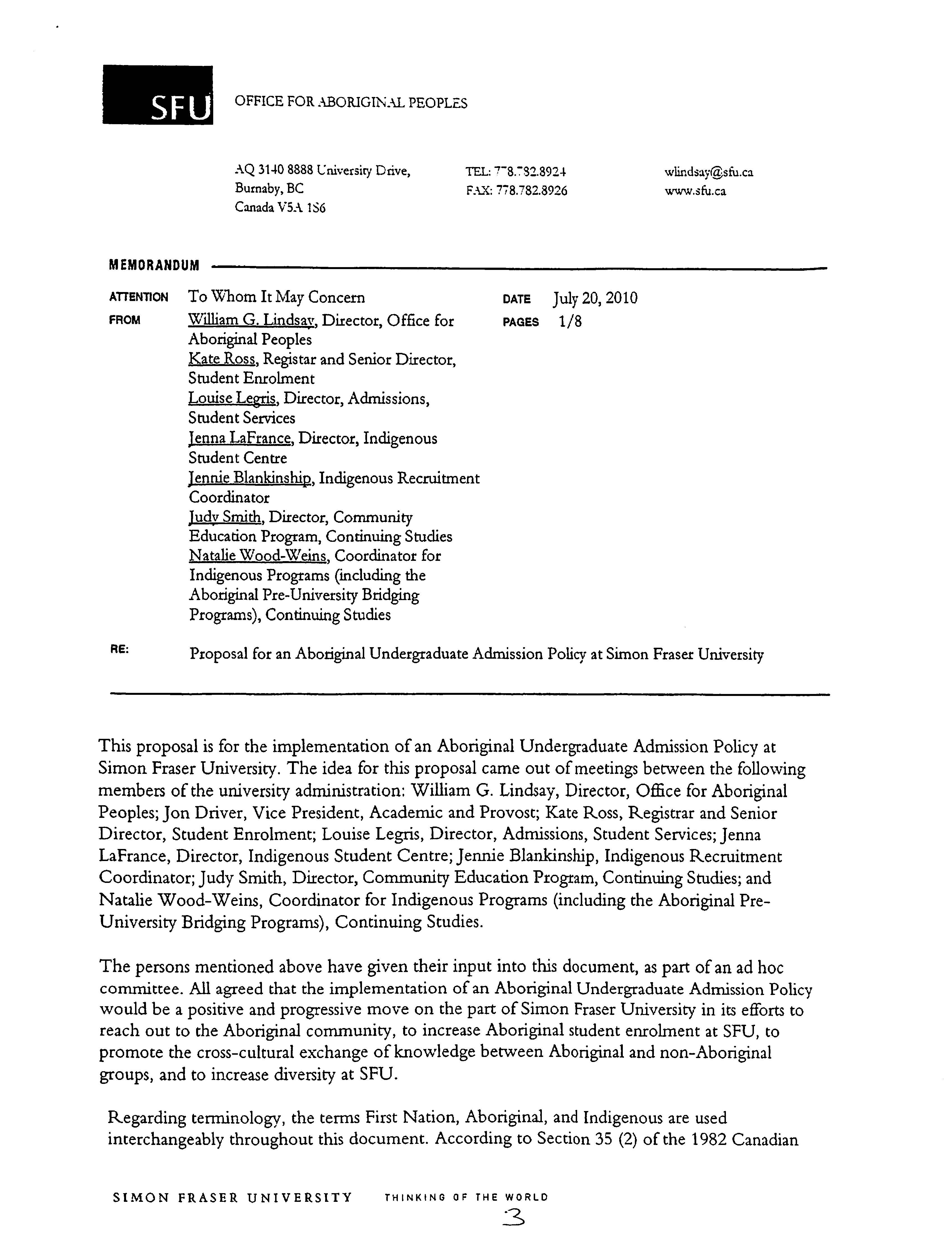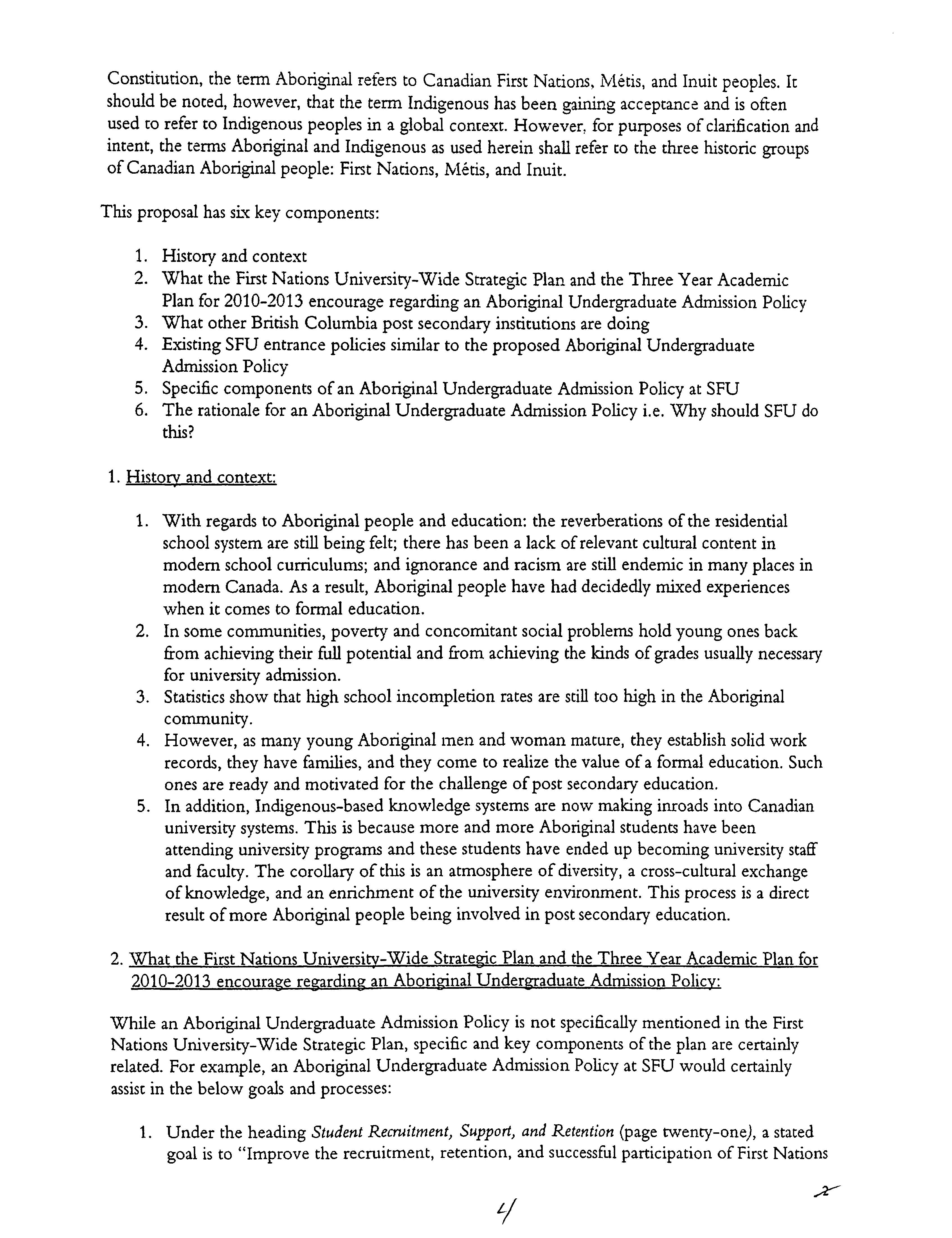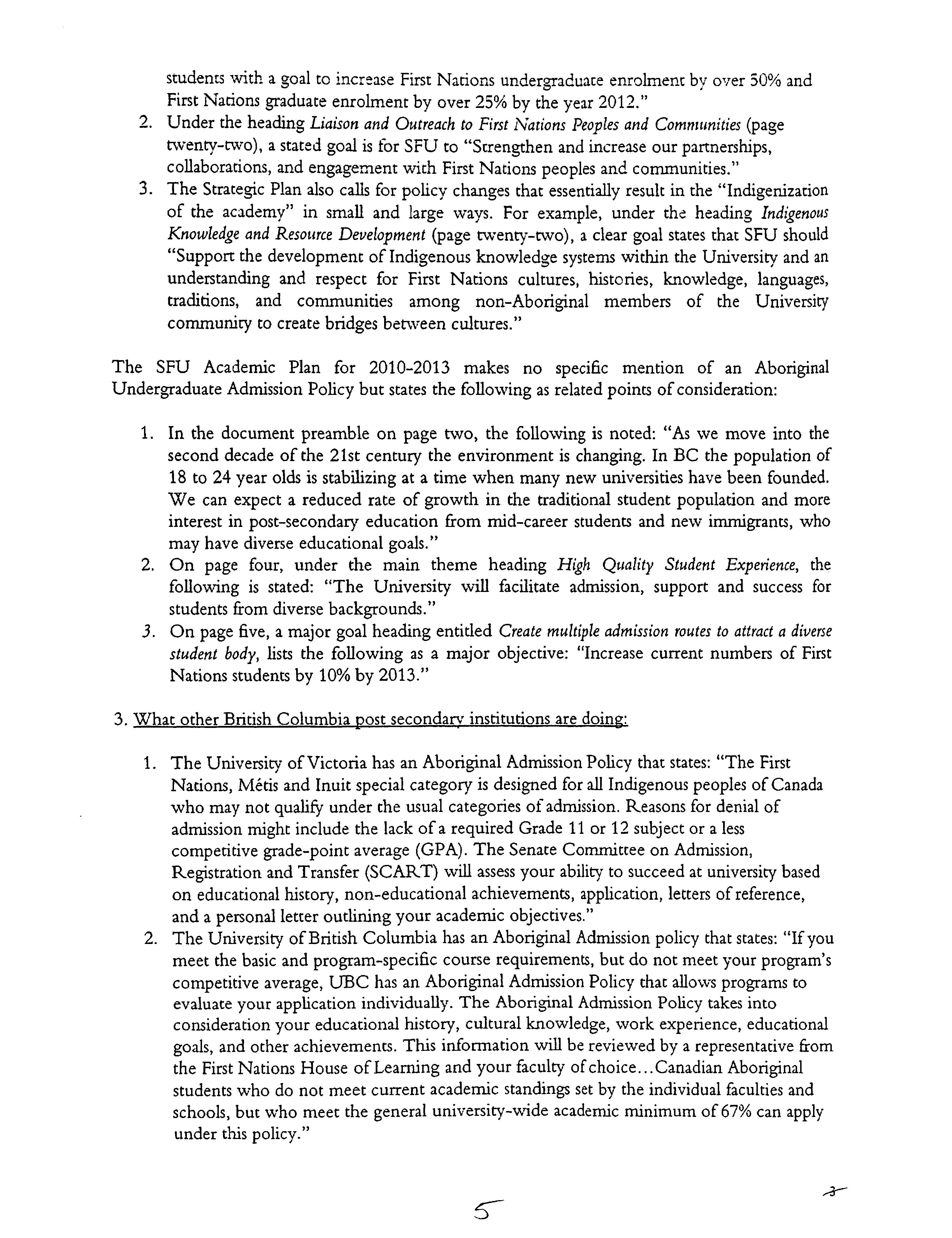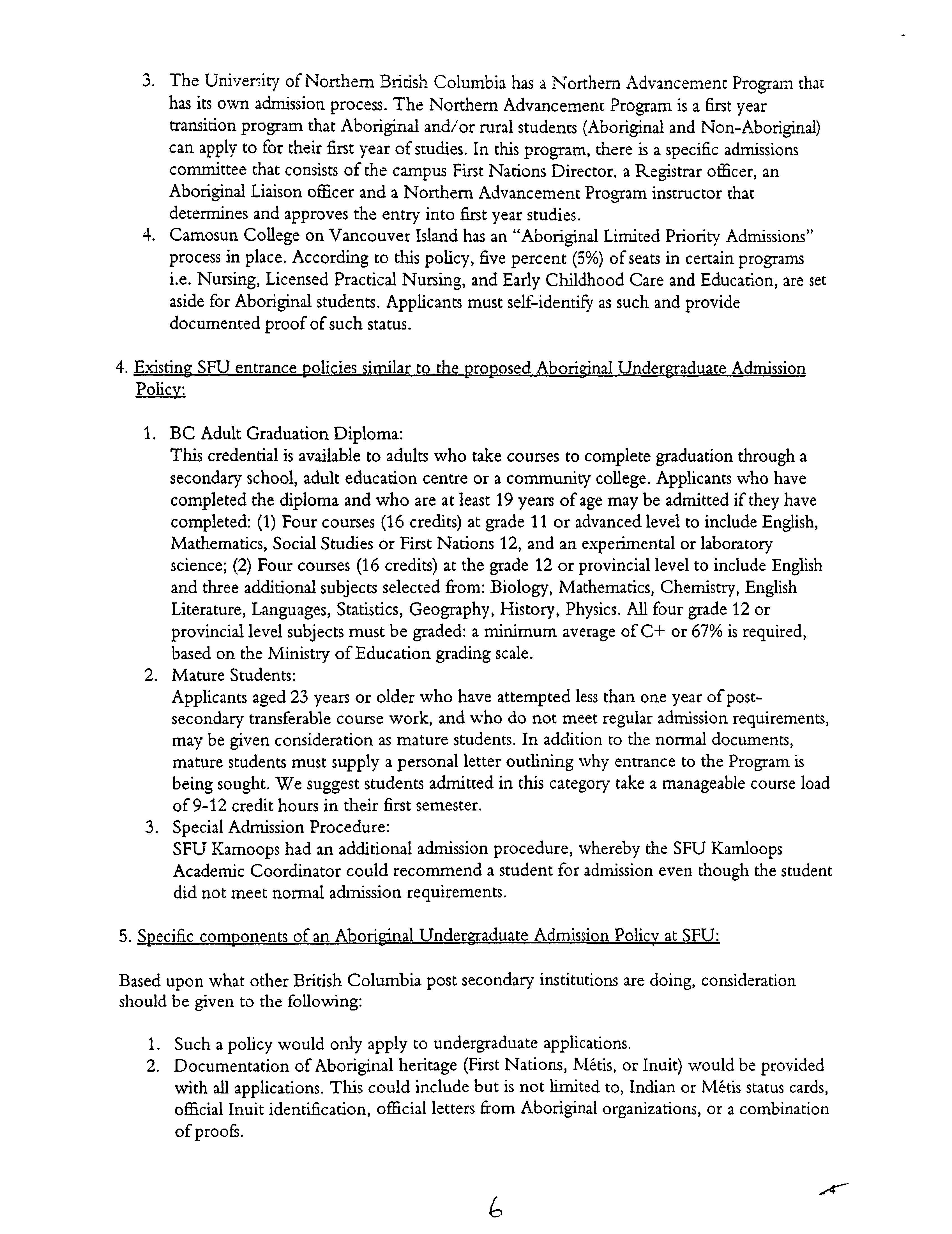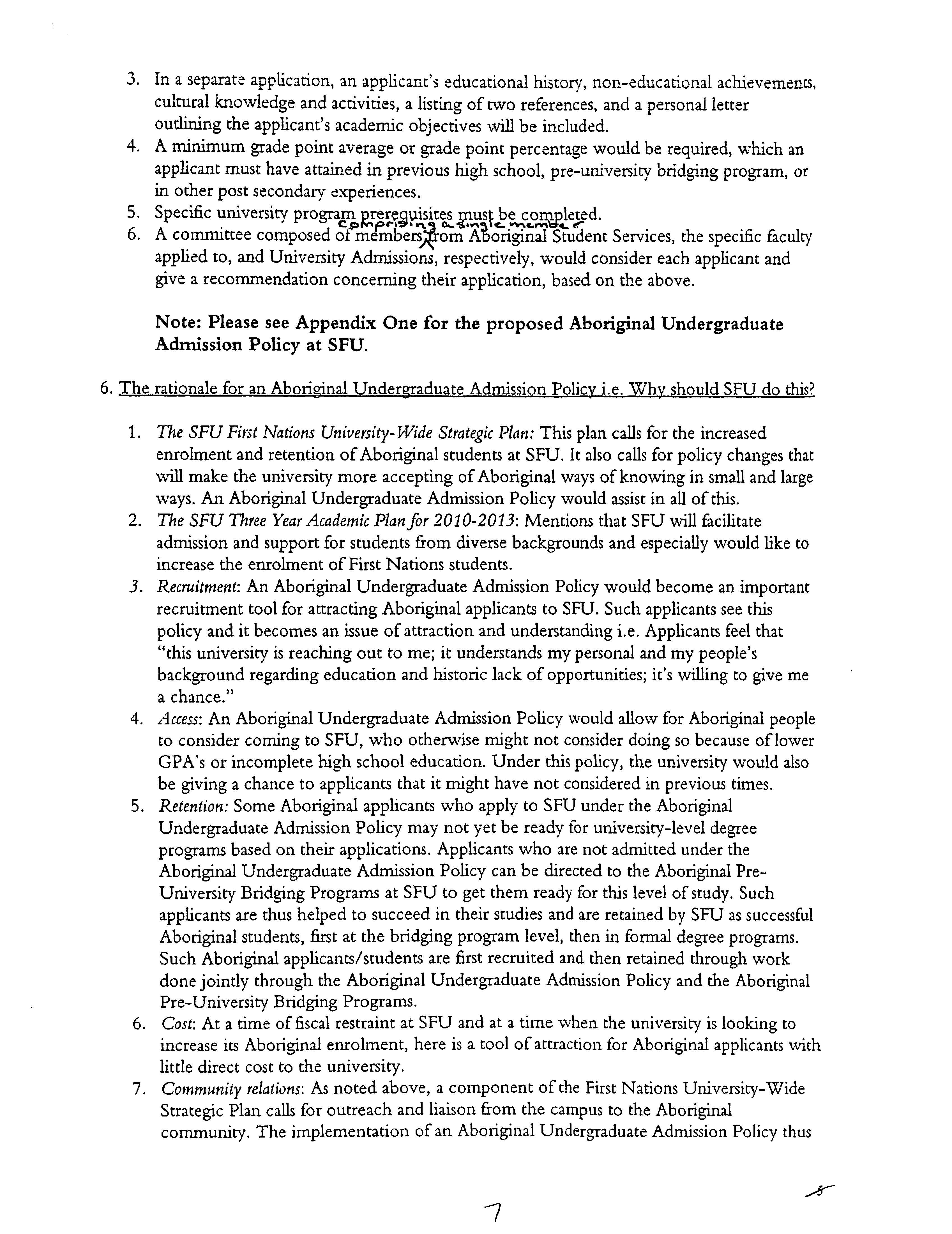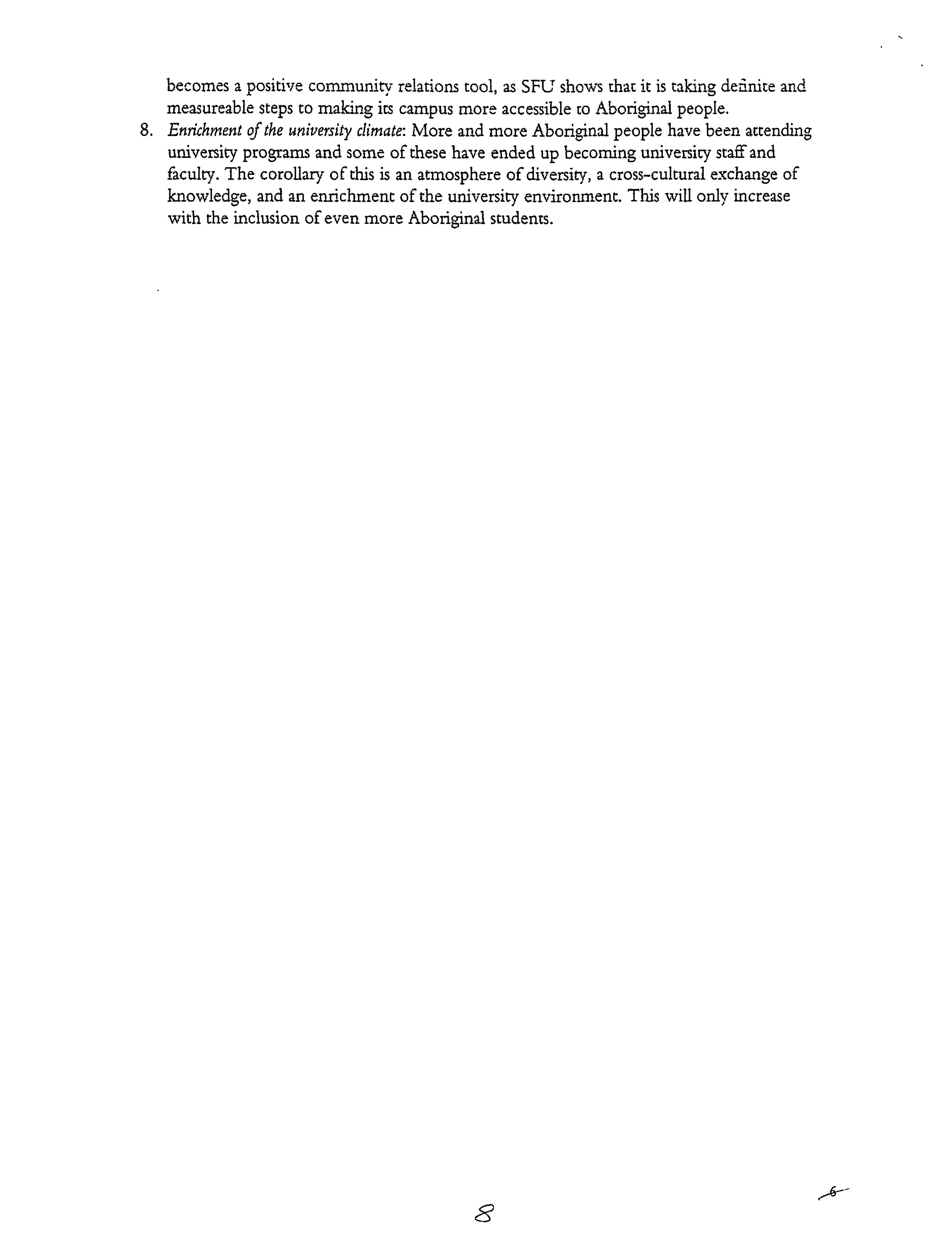S.10-109
OFFICE OF THE ASSOCIATE VICE-PRESIDENT, ACADEM
I
C
AND
ASSOCIATE
PROVOST
8888 Un
i
versity
Drive,
TEL
:
778.782.4636
Burnaby,
BC
FA
X:
778.782.5876
Ca nada
V5A 1
S6
avpciofasfu
.ca
www
.s
fu
.c
a/vpacademic
MEMORANDUM
ATIEN
TI
ON
Senate
DAT
E
August
1
3,2010
FROM
RE:
B
i
ll Krane, Cha
i
r
Senate Committ
ee
on
U
n
dergraduate
Studies
PAGES
1/1
Abo
ri
g
i
nal
Und
ergraduate
Admission Po
li
cy
[SCUS
1
0-35)
Action undertaken by
th
e Senate
Comm
itt
ee
on Undergraduate Studies
at
its meeting
of
August
12,
2010, gives
rise
to the following recommendation:
Motion:
That
Senate approve
the
Aboriginal Undergraduate
Admiss
i
on Poli
c
y
effect
i
ve
September
20
10.
S
I
MON
H
IASE
R
UN
I
VERSITY
T
HIN
K
ING
O
F THE WORLD
REGlSTR,\R & STUDENT ENROLMENT
Srudent Services
MEMORANDUM
ATTENTION
SCUS
3000 l\bggie Benston Centre
8888 University Drive, Burnaby,
BC
Canada VSA 1 S6
FROM
William Lindsay
Director,
Office for Aboriginal
Peoples
Kate Ross
Registrar
&
Senior Director, Student
Enrolment
TEL 778.782.3108
FAX 778.782.5732
DATE
July 19, 2010
PAGES 1
RE:
Aboriginal Undergraduate Admission Policy
SCUS 10-35 REVISED
srudents.sfu.ca
Attached is a proposal for the development of an Aboriginal Undergraduate Admission Policy.
Motion:
that SCUS approve and recommend to Senate the Aboriginal Undergraduate ""'-
Admission Policy as outlined in Appendix One. (t:..f..¥ccli'v-e...
5er+-
'20/0 )
SIMON FRASER UNIVERSITY
THINKING OF iHE WORLD
SFU
OFFICE
FORABORIGI1'-i.\L
PEOPLES
.\Q 3140 8888 Cniversiry Drive,
Burnaby,
Be
TEL:
7-8::·S2.892~
F.~~:
7;8.782.8926
Canada VS.-\.
lS6
MEMORANDUM
ATIENTION
To \\inom It
1fay
Concern
FROM
William G. Lindsay, DiJ:ector, Office for
Aboriginal Peoples
Kate Ross, Registar and Senior DiJ:ector,
Student Eru:olment
Louise Legris, Director, Admissions,
Student Services
lenna LaFrance, Director, Indigenous
Studen
t
Centre
Jennie Blankinship, Indigenous Recruitment
Coordinator
Judv Smith, DiJ:ector, Community
Education Program, Continuing Studies
Natalie Wood-Weins, Coordinator for
Indigenous Programs (including the
Aboriginal Pre-University Bridging
Programs), Continuing Studies
DATE
July 20,2010
PAGES
1/8
wlindsay@sfu.ca
~'WW.sfu.ca
RE:
Proposal for an Aboriginal Undergraduate Admission Policy at Simon Fraser University
This proposal is for the implementation of an Aboriginal Undergraduate Admission Policy at
Simon Fraser University. The idea for this proposal came out of meetings bernreen the follo\ving
members
of the university administration: William G. Lindsay, Director, Office for Aboriginal
Peoples;
Jon Driver, Vice President, Academic and Provost; Kate Ross, Registrar and Senior
Director, Student Enrolment; Louise Legris, Director, Admissions, Student Services; Jenna
LaFrance, Director, Indigenous
Student Centre; Jennie Blankinship, Indigenous Recruitment
Coordinator; Judy
Smith, Director, Community Education Program, Continuing Studies; and
Natalie Wood-Weins, Coordinator for Indigenous Programs (including the Aboriginal
Pre-
University Bridging Programs), Continuing Studies.
The persons mentioned above have given their input into this document, as part of an ad hoc
committee. All agreed that the implementation of an Aboriginal Undergraduate Admission Policy
would be a positive and progressive move on the part of Simon Fraser University in its efforts to
reach
out to the Aboriginal community, to increase Aboriginal student enrolment at SFU, to
promote the cross-cultural exchange
of knowledge between AbOriginal and non-Aboriginal
groups, and to increase diversity at
SFU.
Regarding tenninology, the terms First Nation, Aboriginal, and Indigenous are used
interchangeably throughout
this document. According to Section 35
(2)
of the 1982 Canadian
SIMON FRASER UNIVERSITY
THINKING OF THE WORLD
Constitution, the tenn Aboriginal refers to Canadian First
Nations~
Nletis, and Inuit peoples. It
should
be noted, however, that the term Indigenous has been gaining acceptance and is often
used to refer
to Indigenous peoples in a global context. Hov.rever: for purposes of clarification and
intent, the terms Aboriginal and Indigenous as used herein shall refer to the three historic groups
of Canadian Aboriginal people: First Nations,
~letis,
and Inuit.
This proposal has
six key components:
1. History and context
2. What the First Nations University-Wide Strategic Plan and the Three Year Academic
Plan for
2010-2013 encourage regarding an Aboriginal Undergraduate Admission Policy
3. What other British Columbia post secondary institutions are doing
4. Existing SFU entrance policies similar to the proposed Aboriginal Undergraduate
Admission Policy
5. Specific components of an Aboriginal Undergraduate Admission Policy at SFU
6. The rationale for an Aboriginal Undergraduate Admission Policy i.e. Why should SFU do
this?
1.
History and context:
1.
With regards to Aboriginal people and education: the reverberations of the residential
school system are still
being felt; there has been a lack of relevant cultural content in
modem school curriculums; and ignorance and racism are still endemic in many places in
modem Canada. As a result, Aboriginal people have had decidedly mixed experiences
'when it comes to fonnal education.
2.
In some communities, poverty and concomitant social problems hold young ones back
from achieving their full
potential and from achieving the kinds of grades usually necessary
for university admission.
3. Statistics sho\v that
high school incompletion rates are still too high in the Aboriginal
community.
4. However, as many young Aboriginallnen and woman mature, they establish solid work
records, they have families, and they come to realize the value of a formal education. Such
ones are ready and motivated for
the challenge of post secondary education.
5.
In addition, Indigenous-based knowledge systems are now making inroads into Canadian
university systems. This
is because more and more Aboriginal students have been
attending university programs and these students have ended up becoming university staff
and faculty. The corollary of this is an atmosphere of diversity, a cross-cultural exchange
of knowledge, and an enrichment of the university environment. This process is a direct
result
of more Aboriginal people being involved in post secondary education.
2. What the First Nations University-Wide Strategic Plan and the Three Year Academic Plan for
2010-2013 encourage regarding an Aboriginal Undergraduate Admission Policy:
While an Aboriginal Undergraduate Admission Policy is not specifically mentioned in the First
Nations University-Wide Strategic
Plan, specific and key components of the plan are certainly
related.
For example, an Aboriginal Undergraduate Admission Policy at SFU would certainly
assist in the
below goals and processes:
1.
Under the heading
Student Recruitment, Support, and Retention
(page twenty-one), a stated
goal
is to "Improve the recruitment, retention, and successful participation of First Nations
students with a goal to increase First Nations undergraduace enrolment by over 50% and
First Nations graduate enrolment by over 25% by the year 2012."
2. Under the heading
Liaison and Outreach to First Nations Peoples and Communities
(page
t\venty-t\vo), a stated goal is for SFU to "Strengthen and increase our partnerships,
collaborations, and engagement with First Nations peoples and communities."
3.
The Strategic Plan also calls for policy changes that essentially result in the "Indigenization
of the academy" in small and large ways. For example, under
th~
heading
Indigenous
Knowledge and Resource Development
(page t\venty-two), a clear goal states that SFU should
"Support the development of Indigenous knowledge systems within the University and an
understanding and respect for First Nations cultures, histories, knowledge, languages,
traditions, and communities among non-Aboriginal members
of the University
communiry to create bridges bet\veen cultures."
The SFU Academic Plan for 2010-2013 makes no specific mention of an Aboriginal
Undergraduate Admission Policy but states the follo\ving as related points of consideration:
1.
In the document preamble on page t\vo) the follo\ving is noted: "As \ve move into the
second decade of the 21st century the environment is changing. In BC the population of
18 to 24 year olds is stabilizing at a time when many new universities have been founded.
We can expect a reduced rate of growth in the traditional student population and more
interest
in post-secondary education from mid-career students and ne\v immigrants, who
may have diverse educational
goals."
2. On page four, under the main theme heading
High Quality Student Experience,
the
following
is stated: "The University \vill facilitate admission, support and success for
students from diverse backgrounds.
t)
3. On page five, a major goal heading entitled
Create multiple admission routes to attract a diverse
student body,
lists the following as a major objective: "Increase current numbers of First
Nations students by 10% by 2013."
3. What other British Columbia post secondarY institutions are doing:
1.
The University of Victoria has an Aboriginal Admission Policy that states: "The First
Nations,
Metis and Inuit special category is designed for
all
Indigenous peoples of Canada
\vho may
not qualify under the usual categories of admission. Reasons for denial of
admission might include the lack of a required Grade 11 or 12 subject or a less
competitive grade-point average (GPA). The Senate Committee on Admission,
Registration and Transfer
(SCART) \vill assess your ability to succeed at university based
on educational history, non-educational achievements, application, letters of reference,
and a personal letter outlining your academic objectives."
2. The University of British Columbia has an Aboriginal Admission policy that states: "If you
meet the basic and program-specific course requirements, but do not meet your program's
competitive average,
UBe
has an Aboriginal Admission Policy that allO\VS programs to
evaluate your application individually.
The Aboriginal Admission Policy takes into
consideration
your educational history, cultural knowledge, \vork experience, educational
goals, and other achievements. This infonnation will be reviewed by a representative from
the First Nations House
of Learning and your faculty of choice ... Canadian Aboriginal
students \vho do not
meet current academic standings set by the individual faculties and
schools,
but who meet the general university-wide academic minimum of 67% can apply
under
trus policy."
3. The University of Northern British Columbia has a Northern Advancement Program thar
has its own admission process. The Northern Advancement Program is a first year
transition program that Aboriginal
and/or rural students (Aboriginal and Non-Aboriginal)
can apply to for their first year
of studies. In this program, there is a specific admissions
committee that consists
of the campus First Nations Director, a Registrar officer, an
Aboriginal Liaison officer and a
Northern Advancement Program instructor that
determines and approves the entry into first year studies.
4. Camosun College on Vancouver Island has an "Aboriginal Limited Priority Admissions"
process in place. According to this policy,
five percent
(5%)
of seats in certain programs
i.e. Nursing, Licensed Practical Nursing, and Early Childhood Care and Education, are
set
aside for Aboriginal students. Applicants must self-identify as such and provide
documented
proof of such status.
4. Existing SFU entrance policies similar to the proposed Aboriginal Undergraduate Admission
Policy:
1. BC Adult Graduation Diploma:
This credential
is available to adults 'who take courses to complete graduation through a
secondary school, adult education centre or a community college. Applicants
"v-ho have
completed the diploma and
who are at least 19 years of age may be admitted if they have
completed:
(1) Four courses (16 credits) at grade 11 or advanced level to include English,
Mathematics,
Social Studies or First Nations 12, and an experimental or laboratory
science;
(2) Four courses (16 credits) at the grade 12 or provincial level to include English
and three additional subjects selected from: Biology, Mathematics, Chemistry, English
Literature, Languages, Statistics,
Geography, History, Physics. All four grade 12 or
provincial level subjects must
be graded: a minimum average of C+ or 67% is required,
based
on the Ministry of Education grading scale.
2. Mature Students:
Applicants aged 23 years or older who have attempted less than one year of post-
secondary transferable course
work, and \\-ho do not meet regular admission requirements,
may be given consideration
as mature students. In addition to the nonnal documents,
mature students must supply a personal letter outlining why entrance to the Program
is
being sought. We suggest students admitted in this category take a manageable course load
of 9-12 credit hours in their first semester.
3.
Special Admission Procedure:
SFU Kamoops had an additional admission procedure, whereby the SFU Kamloops
Academic Coordinator could reconunend a student for admission even though the student
did not meet nonnal admission requirements.
5. Specific components of an Aboriginal Undergraduate Admission Policy at SFU:
Based upon what other British Columbia post secondary institutions are doing, consideration
should be given to the following:
1. Such a policy would only apply to undergraduate applications.
2. Documentation of Aboriginal heritage (First Nations, !\iletis, or Inuit) would be provided
with
all applications. This could include but is not limited to, Indian or Metis status cards,
official Inuit identification, official letters from Aboriginal organizations,
or a combination
of proofs.
3. In a separate application, an applicanes educational history, non-educational achievemencs,
cultural kno\vledge and activities, a listing
of nvo references, and a personal letter
oudining the applicant's academic objectives
vvili be included.
4. A
minimum grade point average or grade point percentage would be required, v..hich an
applicant must have attained
in
previous high school, pre-university bridging program, or
in other post secondary
~xperiences.
5.
Specific
university
.
progr<l;m
C,.p""P~~".
orereot,lisites
~_ ~~.",~r<-
must
be
~C.M-=r4..
comnleted.
~
6. A comnuttee composed ot
membe~om
Aboriginal Student Services, the specific faculty
applied to, and
University Admissions, respectively, vvould consider each applicant and
give a reconunendation concerning their application, based
on the above.
Note: Please see Appendix One for the proposed Aboriginal Undergraduate
Admission
Policy at SFU.
6. The rationale for an Aboriginal Undergraduate Admission Policy i.e. Why should SFU do this?
1. The SFU First Nations University- vVide Strategic Plan:
This plan calls for the increased
enrolment and retention
of Aboriginal students at SFU. It also calls for policy changes that
\vill make the university
more accepting of Aboriginal ways of knowing in small and large
\vays. An Aboriginal Undergraduate Admission Policy would assist in all of this.
2.
The
SFU
Three Year Academic Planfor
2010-2013:
Mentions that SFU Vvill facilitate
admission and support for students from diverse backgrounds and especially would like
to
increase the enrolment of First Nations students.
3. Recruitment:
An Aboriginal Undergraduate Admission Policy .would become an important
recruitment tool for attracting Aboriginal applicants to
SFU. Such applicants see this
policy and it becomes an issue
of attraction and understanding i.e. Applicants feel that
"this university
is reaching out to me; it understands my personal and my people's
background regarding education and historic lack
of opportunities; it's willing to give me
a chance."
4.
Access:
An Aboriginal Undergraduate Admission Policy would allO\V for Aboriginal people
to consider coming to
SFU, who otherwise might not consider doing so because oflo\ver
GPA's
or incomplete high school education. Under this policy, the university would also
be giving a chance to applicants that it might have not considered in previous times.
5. Retention:
Some Aboriginal applicants \vho apply to SFU under the Aboriginal
Undergraduate Admission
Policy may not yet be ready for university-level degree
programs based
on their applications. Applicants vvho are not admitted under the
Aboriginal Undergraduate Admission Policy can be directed to the Aboriginal
Pre-
University Bridging Programs at SFU to get them ready for this level of study. Such
applicants are thus helped to succeed in their studies and are retained by
SFU as successful
Aboriginal students, first at the bridging program level, then in fonnal degree programs.
Such Aboriginal applicants/students are first recruited and then retained through work
done jointly through the Aboriginal Undergraduate Admission
Policy and the Aboriginal
Pre-University Bridging Programs.
6.
Cost:
At a time of fiscal restraint at SFU and at a time vvhen the university is looking to
increase
its Aboriginal enrolment, here is a tool of attraction for Aboriginal applicants with
little direct cost to the university.
7. Community relations:
As noted above, a component of the First Nations University-Wide
Strategic
Plan calls for outreach and liaison from the campus to the Aboriginal
community.
The implementation of an Aboriginal Undergraduate Admission Policy thus
becomes a positive community relations tool, as SFlJ shov,,"s that: it is takil'1g definite and
measureable steps to making
its campus more accessible to Aboriginal people.
S.
Enrichment
oj
the university climate:
More and more Aboriginal people have been attending
university programs and some
of these have ended up becoming university staff and
faculty.
The corollary of this is an atmosphere of diversity, a cross-cultural exchange of
knowledge, and an enrichment of the university environment. This 'will only increase
with the inclusion
of even more Aboriginal students.
8
Appendix One
Aboriginal Undergraduate Admission Policy
Simon Fraser University
Aboriginal
Undergraduate
Admission
Policy -
Calendar Ently
The
tem1
Aboriginal Peoples refers to First Nations, Metis,
and
Inuit peoples of
Canada
.
Aboriginal applicants who
do
not meet the competitive average
se
t
by individual faculties and
sc
ho
o
ls
can apply
under
this policy
.
Applicants must normally be high school graduates and
m
eet
the
gener
al university
minimum requirements for admission. Aboriginal applicants who meet the
competitive average and general
university
requirements should apply directly to their faculty
or
program of choice. See
h
t
tp
://s
tud
e
nt
s
.
s
fu
.
c
a
hd
mi
ss
i
o
n
/
ind
ex
.
html
for general
univer
s
ity
admission
requir
ements
.
The Aboriginal Undergraduate Admission Policy takes
into
consideration an applicant's
educa
tional
history, cultural knowledge,
work
experience, educat
ional
goals, and other
achievements
.
TillS
infom1ation will be
review
ed
by
a three member
commi
ttee
composed of
participants from the
Indigenous
Student
Centre,
the specific faculty applied to, and
Univ
ers
ity
Admissions.
Applicants applying
under
the Aboriginal Undergraduate Admission Policy must meet the
following requirements:
1. Provide
doc
umentation
of Aboriginal
h
eritage
(First Nations, Metis, or
Inuit).
This could
include
but
i
s
not
limited to,
Indian
or Metis
status cards,
official Inuit
identifi
cat
ion
,
official
letters
from
Aboriginal
organizations,
or a combination of proofs.
2. Complete a separate
Supplemental Aboriginal Undergraduate Admission Form
containing
th
e
following
inform
ation:
an applicant's
educational
hi
story,
non-educational achievements,
Aboriginal cultural knowledge and
act
ivities
,
two references, and a
per
sonal
letter
outlining the applicant's academic goals.
3.
Specific faculty/program prerequisites must be
comp
l
eted
before
cons
ide
ratio
n
for
admission to certain
program
s
.
Applicants
who
do not
qualifY for admission
under tills
policy may qualifY for the Aboriginal
University
Prep Programs
.
For infoI11h1tion
on
tills
program
see
http
://w
ww
.
s
fu
.
c
a
/cs
tudi
es/co
l11l11unit
v/a
b
o
ri
g
inal
.
htl11
.
S
IM
ON
FRASER UNIVERSITY
TH
INKING OF THE
WORLD



